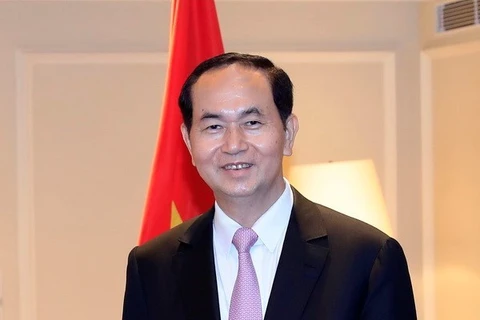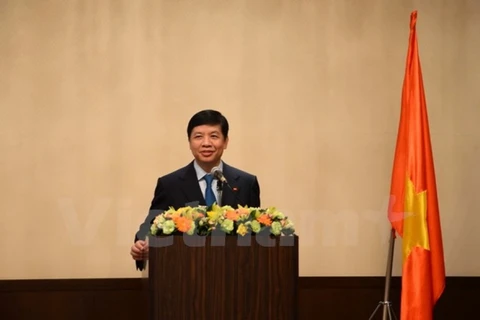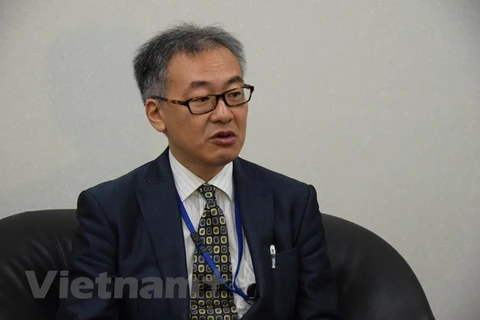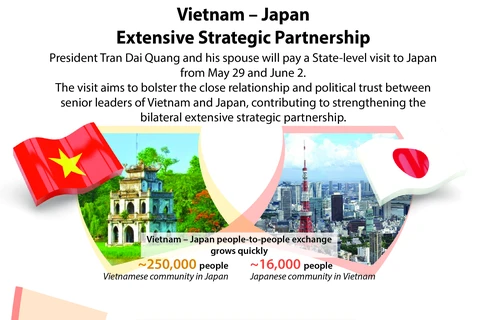Hanoi (VNA) – President Tran Dai Quang’s State visit to Japan from May 29 – June 2 is expected to breath new life into bilateral trade in the near future.
Since the establishment of the extensive strategic partnership for peace and prosperity in Asia in March 2014, Vietnam – Japan ties have thrived.
According to the Ministry of Industry and Trade (MoIT), Vietnam’s exports to Japan hit 2.7 billion USD as of early March, up nearly 14.3 percent annually, mostly apparel (537 million USD), means of transportation (365.2 million USD) and machinery and equipment (259 million USD).
During the period, the country spent 2.705 billion USD on imports from Japan, up nearly 17 percent annually, resulting in a trade deficit of roughly 5 million USD. Most imports were machinery and equipment (675 million USD); computers, electronics and spare parts (392 million USD) and iron and steel (203 million USD).
A survey recently announced by the Japan External Trade Organisation (JETRO) named Vietnam the second best business destination for Japanese firms, behind China.
As of late March, Japan recorded 3,693 projects in Vietnam with a total registered capital of more than 49.8 billion USD, ranking second out of 116 countries and territories investing in the country.
From the beginning of this year to March 20, Japan posted 96 newly-licensed projects, 42 others with additional capital and 112 purchases of shares worth roughly 593 million USD, ranking fourth out of countries and territories investing in Vietnam.
Japan is the largest provider of official development assistance to Vietnam, focusing on infrastructure, competitiveness, high-quality human resources training, climate change response and other fields.
Hoang Quang Phong, Vice Chairman of the Vietnam Chamber of Commerce and Industry, suggested continuing to improve administrative reform and corporate competitiveness and enhancing production output while tapping potential in agriculture, tourism, human resources training, transportation and distribution.
Deputy head of the MoIT’s Department of the Asia-Pacific Markets Le An Hai said Vietnam’s benefits from the Vietnam – Japan Economic Partnership Agreement (VJEPA) and free trade agreements are yet to reflect bilateral trade potential.
Under the Vietnam – Japan free trade agreement, average taxes on Vietnam’s exports to Japan will be cut to 2.8 percent this year. At least 86 percent of agro-forestry-aquatic products and 97 percent of industrial goods exported to Japan will enjoy preferential tariffs.
Taxes on Japan’s exports to Vietnam will be reduced to 7 percent in 2018. The strongest free trade commitments are given to farm produce, aquatic products, apparel, iron and steel, chemicals and electronic spare parts.
In the next decade, Vietnam and Japan will basically complete a tax reduction roadmap to build a free trade area. Accordingly, 94.53 percent of Vietnam’s exports and 87.6 percent of Japan’s exports will enjoy import tax exemption.
Therefore, Hai asked Vietnamese businesses to improve trade capacity and closely oversee export quality standards.
To lift exports to Japan, analysts advised domestic firms to devise business strategies based on reviewing their strengths, weaknesses, opportunities and challenges, existing positions and goals.
Minister of Industry and Trade Tran Tuan Anh asked for effectively realising the VJEPA to double two-way trade and investment by 2020 compared to 2014.
Both sides need to facilitate trade in farm produce and aquatic products, effectively realise the Vietnam – Japan Joint Initiative to improve business climate and promote Japanese investment in Vietnam, he said.
He underscored the need to launch action plans for six industries chosen in Vietnam’s Industrialisation Strategy within the Vietnam – Japan cooperation framework towards 2020 with vision to 2030, towards lifting two-way trade in the near future.-VNA
Since the establishment of the extensive strategic partnership for peace and prosperity in Asia in March 2014, Vietnam – Japan ties have thrived.
According to the Ministry of Industry and Trade (MoIT), Vietnam’s exports to Japan hit 2.7 billion USD as of early March, up nearly 14.3 percent annually, mostly apparel (537 million USD), means of transportation (365.2 million USD) and machinery and equipment (259 million USD).
During the period, the country spent 2.705 billion USD on imports from Japan, up nearly 17 percent annually, resulting in a trade deficit of roughly 5 million USD. Most imports were machinery and equipment (675 million USD); computers, electronics and spare parts (392 million USD) and iron and steel (203 million USD).
A survey recently announced by the Japan External Trade Organisation (JETRO) named Vietnam the second best business destination for Japanese firms, behind China.
As of late March, Japan recorded 3,693 projects in Vietnam with a total registered capital of more than 49.8 billion USD, ranking second out of 116 countries and territories investing in the country.
From the beginning of this year to March 20, Japan posted 96 newly-licensed projects, 42 others with additional capital and 112 purchases of shares worth roughly 593 million USD, ranking fourth out of countries and territories investing in Vietnam.
Japan is the largest provider of official development assistance to Vietnam, focusing on infrastructure, competitiveness, high-quality human resources training, climate change response and other fields.
Hoang Quang Phong, Vice Chairman of the Vietnam Chamber of Commerce and Industry, suggested continuing to improve administrative reform and corporate competitiveness and enhancing production output while tapping potential in agriculture, tourism, human resources training, transportation and distribution.
Deputy head of the MoIT’s Department of the Asia-Pacific Markets Le An Hai said Vietnam’s benefits from the Vietnam – Japan Economic Partnership Agreement (VJEPA) and free trade agreements are yet to reflect bilateral trade potential.
Under the Vietnam – Japan free trade agreement, average taxes on Vietnam’s exports to Japan will be cut to 2.8 percent this year. At least 86 percent of agro-forestry-aquatic products and 97 percent of industrial goods exported to Japan will enjoy preferential tariffs.
Taxes on Japan’s exports to Vietnam will be reduced to 7 percent in 2018. The strongest free trade commitments are given to farm produce, aquatic products, apparel, iron and steel, chemicals and electronic spare parts.
In the next decade, Vietnam and Japan will basically complete a tax reduction roadmap to build a free trade area. Accordingly, 94.53 percent of Vietnam’s exports and 87.6 percent of Japan’s exports will enjoy import tax exemption.
Therefore, Hai asked Vietnamese businesses to improve trade capacity and closely oversee export quality standards.
To lift exports to Japan, analysts advised domestic firms to devise business strategies based on reviewing their strengths, weaknesses, opportunities and challenges, existing positions and goals.
Minister of Industry and Trade Tran Tuan Anh asked for effectively realising the VJEPA to double two-way trade and investment by 2020 compared to 2014.
Both sides need to facilitate trade in farm produce and aquatic products, effectively realise the Vietnam – Japan Joint Initiative to improve business climate and promote Japanese investment in Vietnam, he said.
He underscored the need to launch action plans for six industries chosen in Vietnam’s Industrialisation Strategy within the Vietnam – Japan cooperation framework towards 2020 with vision to 2030, towards lifting two-way trade in the near future.-VNA
VNA

























